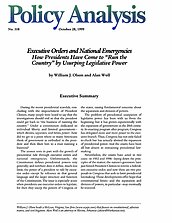The answer rests in part with the growth of presidential rule through executive orders and national emergencies. Unfortunately, the Constitution defines presidential powers very generally; and nowhere does it define, much less limit, the power of a president to rule by executive order–except by reference to that general language and the larger structure and function of the Constitution. The issue is especially acute when presidents use executive orders to legislate, for then they usurp the powers of Congress or the states, raising fundamental concerns about the separation and division of powers.
The problem of presidential usurpation of legislative power has been with us from the beginning, but it has grown exponentially with the expansion of government in the 20th century. In enacting program after program, Congress has delegated more and more power to the executive branch. Thus, Congress has not only failed to check but has actually abetted the expansion of presidential power. And the courts have been all but absent in restraining presidential lawmaking.
Nevertheless, the courts have acted in two cases–in 1952 and 1996–laying down the principles of the matter; the nation’s governors have just forced President Clinton to rewrite a federalism executive order; and now there are two proposals in Congress that seek to limit presidential lawmaking. Those developments offer hope that constitutional limits–and the separation and division of powers, in particular–may eventually be restored.

